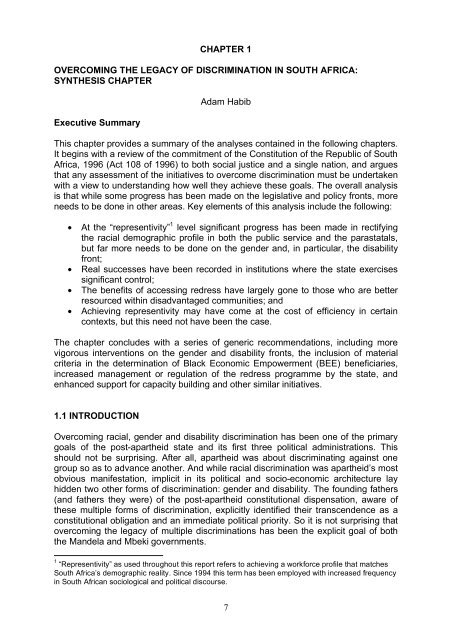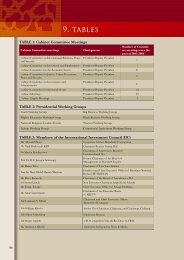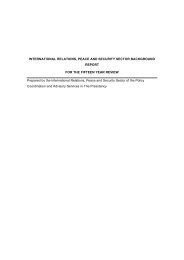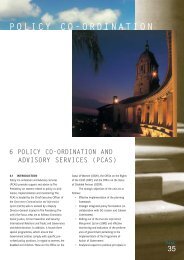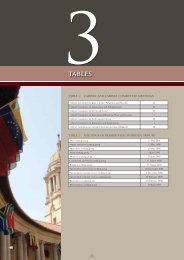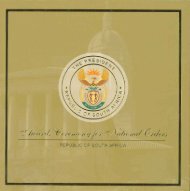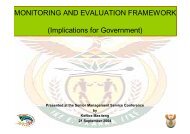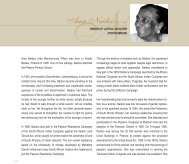Chapter 1 Overcoming the legacy of discrimination ... - The Presidency
Chapter 1 Overcoming the legacy of discrimination ... - The Presidency
Chapter 1 Overcoming the legacy of discrimination ... - The Presidency
Create successful ePaper yourself
Turn your PDF publications into a flip-book with our unique Google optimized e-Paper software.
CHAPTER 1<br />
OVERCOMING THE LEGACY OF DISCRIMINATION IN SOUTH AFRICA:<br />
SYNTHESIS CHAPTER<br />
Executive Summary<br />
Adam Habib<br />
This chapter provides a summary <strong>of</strong> <strong>the</strong> analyses contained in <strong>the</strong> following chapters.<br />
It begins with a review <strong>of</strong> <strong>the</strong> commitment <strong>of</strong> <strong>the</strong> Constitution <strong>of</strong> <strong>the</strong> Republic <strong>of</strong> South<br />
Africa, 1996 (Act 108 <strong>of</strong> 1996) to both social justice and a single nation, and argues<br />
that any assessment <strong>of</strong> <strong>the</strong> initiatives to overcome <strong>discrimination</strong> must be undertaken<br />
with a view to understanding how well <strong>the</strong>y achieve <strong>the</strong>se goals. <strong>The</strong> overall analysis<br />
is that while some progress has been made on <strong>the</strong> legislative and policy fronts, more<br />
needs to be done in o<strong>the</strong>r areas. Key elements <strong>of</strong> this analysis include <strong>the</strong> following:<br />
• At <strong>the</strong> “representivity” 1 level significant progress has been made in rectifying<br />
<strong>the</strong> racial demographic pr<strong>of</strong>ile in both <strong>the</strong> public service and <strong>the</strong> parastatals,<br />
but far more needs to be done on <strong>the</strong> gender and, in particular, <strong>the</strong> disability<br />
front;<br />
• Real successes have been recorded in institutions where <strong>the</strong> state exercises<br />
significant control;<br />
• <strong>The</strong> benefits <strong>of</strong> accessing redress have largely gone to those who are better<br />
resourced within disadvantaged communities; and<br />
• Achieving representivity may have come at <strong>the</strong> cost <strong>of</strong> efficiency in certain<br />
contexts, but this need not have been <strong>the</strong> case.<br />
<strong>The</strong> chapter concludes with a series <strong>of</strong> generic recommendations, including more<br />
vigorous interventions on <strong>the</strong> gender and disability fronts, <strong>the</strong> inclusion <strong>of</strong> material<br />
criteria in <strong>the</strong> determination <strong>of</strong> Black Economic Empowerment (BEE) beneficiaries,<br />
increased management or regulation <strong>of</strong> <strong>the</strong> redress programme by <strong>the</strong> state, and<br />
enhanced support for capacity building and o<strong>the</strong>r similar initiatives.<br />
1.1 INTRODUCTION<br />
<strong>Overcoming</strong> racial, gender and disability <strong>discrimination</strong> has been one <strong>of</strong> <strong>the</strong> primary<br />
goals <strong>of</strong> <strong>the</strong> post-apar<strong>the</strong>id state and its first three political administrations. This<br />
should not be surprising. After all, apar<strong>the</strong>id was about discriminating against one<br />
group so as to advance ano<strong>the</strong>r. And while racial <strong>discrimination</strong> was apar<strong>the</strong>id’s most<br />
obvious manifestation, implicit in its political and socio-economic architecture lay<br />
hidden two o<strong>the</strong>r forms <strong>of</strong> <strong>discrimination</strong>: gender and disability. <strong>The</strong> founding fa<strong>the</strong>rs<br />
(and fa<strong>the</strong>rs <strong>the</strong>y were) <strong>of</strong> <strong>the</strong> post-apar<strong>the</strong>id constitutional dispensation, aware <strong>of</strong><br />
<strong>the</strong>se multiple forms <strong>of</strong> <strong>discrimination</strong>, explicitly identified <strong>the</strong>ir transcendence as a<br />
constitutional obligation and an immediate political priority. So it is not surprising that<br />
overcoming <strong>the</strong> <strong>legacy</strong> <strong>of</strong> multiple <strong>discrimination</strong>s has been <strong>the</strong> explicit goal <strong>of</strong> both<br />
<strong>the</strong> Mandela and Mbeki governments.<br />
1 “Representivity” as used throughout this report refers to achieving a workforce pr<strong>of</strong>ile that matches<br />
South Africa’s demographic reality. Since 1994 this term has been employed with increased frequency<br />
in South African sociological and political discourse.<br />
7
What is surprising, however, is how little reflection <strong>the</strong>re is <strong>of</strong> <strong>the</strong>se processes. Of<br />
course <strong>the</strong>re is much debate in <strong>the</strong> general media on one or o<strong>the</strong>r aspect <strong>of</strong> <strong>the</strong><br />
redress strategies. But this is very rarely supported by or located within a sound<br />
empirical analysis <strong>of</strong> <strong>the</strong> historical or contemporary state <strong>of</strong> affairs. Indeed, <strong>the</strong><br />
debate tends to be polemical and polarised. Part <strong>of</strong> <strong>the</strong> problem lies at <strong>the</strong> feet <strong>of</strong><br />
politicians who unnecessarily polarise this debate to score short-term political points<br />
against <strong>the</strong>ir opponents. 2 But <strong>the</strong> academy and science councils are also complicit for<br />
not explicitly identifying this as a subject <strong>of</strong> investigation and <strong>the</strong>refore as part <strong>of</strong> <strong>the</strong>ir<br />
research agenda. After all how can we transcend <strong>the</strong> legacies <strong>of</strong> our multiple forms <strong>of</strong><br />
<strong>discrimination</strong> if our intelligentsia, both within and outside <strong>the</strong> academy, are not<br />
playing <strong>the</strong>ir part in monitoring, evaluating, and reflecting upon <strong>the</strong> redress strategies<br />
that we, as a nation, have embarked upon?<br />
This is, however, changing. Increasingly, within <strong>the</strong> academy and science councils,<br />
and within <strong>the</strong> government, <strong>the</strong>re is growing recognition <strong>of</strong> <strong>the</strong> need for more<br />
reflection about race, gender and disability <strong>discrimination</strong>, and how <strong>the</strong>se can be<br />
combated and transcended. This study, for example, was initiated at <strong>the</strong> prompting <strong>of</strong><br />
and supported by <strong>the</strong> <strong>Presidency</strong>. And even before <strong>the</strong> Human Sciences Research<br />
Council (HSRC) was approached by <strong>the</strong> <strong>Presidency</strong> in this regard, we had already<br />
begun to develop plans to launch a comprehensive multi-year study on race and<br />
redress in South Africa. Both initiatives are <strong>of</strong> course compatible. This present study<br />
is <strong>of</strong> a shorter duration with its analysis located in secondary material and existing<br />
databases. <strong>The</strong> HSRC multi-year study, given its duration, would be more in-depth,<br />
located in new empirical research. <strong>The</strong> current study will <strong>of</strong> course feed into our<br />
future study, and we are exploring a potential partnership between <strong>the</strong> HSRC and <strong>the</strong><br />
<strong>Presidency</strong> to ensure that <strong>the</strong> results <strong>of</strong> <strong>the</strong> future study feed into policy and decisionmaking<br />
processes within <strong>the</strong> state.<br />
<strong>The</strong>re is perhaps no better time to undertake this study. Nearly 11 years have passed<br />
since our founding elections and we are now in our third political administration. In<br />
<strong>the</strong> political science literature on transition and democratisation, it is assumed that<br />
transitional societies, in <strong>the</strong>ir third term <strong>of</strong> democracy, have entered <strong>the</strong> phase <strong>of</strong><br />
consolidation. Even if we do not buy into this unnecessarily linear and procedural<br />
understanding <strong>of</strong> democratisation and its consolidation, it does seem sensible to<br />
pause and take stock, given that we have just celebrated 10 years <strong>of</strong> democracy. Of<br />
course no definitive conclusions can be drawn <strong>of</strong> <strong>the</strong> success or o<strong>the</strong>rwise <strong>of</strong> redress<br />
strategies initiated over <strong>the</strong> past decade. This is too short a time to judge <strong>the</strong> effects<br />
<strong>of</strong> a political and social transformation exercise. Never<strong>the</strong>less, sufficient time has<br />
passed for us to make provisional judgments on whe<strong>the</strong>r we are on <strong>the</strong> right path,<br />
and whe<strong>the</strong>r adaptations or revisions are required. This <strong>the</strong>n is <strong>the</strong> purpose <strong>of</strong> this<br />
syn<strong>the</strong>sis chapter.<br />
This chapter is premised on four o<strong>the</strong>rs, each focusing on a different arena or<br />
<strong>the</strong>matic area as per our contractual obligations to <strong>the</strong> <strong>Presidency</strong>. <strong>The</strong> four topics<br />
are <strong>the</strong> public service, <strong>the</strong> economy, <strong>Chapter</strong> Nine institutions, and social capital --<br />
including investigations into social inclusion and exclusion. All four topics were<br />
inspired in part by a series <strong>of</strong> questions or <strong>the</strong>matic concerns identified by <strong>the</strong><br />
2 Both <strong>the</strong> ruling party and <strong>the</strong> opposition have been guilty <strong>of</strong> this. Note, for example, Tony Leon’s<br />
“swart gevaar” tactics in <strong>the</strong> last two elections and <strong>the</strong> ANC’s response to <strong>the</strong>se. See Habib and<br />
Naidu, 1999.<br />
8
<strong>Presidency</strong>, and contained in <strong>the</strong> document attached as Appendix 1. However, it<br />
should be noted that <strong>the</strong> following chapters are not structured to answer those<br />
questions in an instrumental sense. Instead, <strong>the</strong> questions and concerns inspired <strong>the</strong><br />
research problematic <strong>of</strong> <strong>the</strong>se chapters, and in that sense <strong>the</strong> questions are more<br />
substantive ra<strong>the</strong>r than instrumentally addressed.<br />
One fur<strong>the</strong>r preliminary comment needs to be made regarding methodology. At <strong>the</strong><br />
outset it must be noted that this research does not generate new empirical<br />
information in its own right. Indeed given <strong>the</strong> time constraints imposed by <strong>the</strong><br />
<strong>Presidency</strong>, it would have been impossible to generate new empirical research on<br />
<strong>the</strong> <strong>the</strong>matic issues under consideration. Instead, both <strong>the</strong> <strong>Presidency</strong> and <strong>the</strong> HSRC<br />
recognised that new empirical information would be generated from our future multiyear<br />
study, and that this study would be located on secondary and existing<br />
databases, most <strong>of</strong> which have information generated for o<strong>the</strong>r purposes.<br />
Never<strong>the</strong>less, <strong>the</strong> research team did consult and analyse a diverse range <strong>of</strong><br />
materials to try and read from <strong>the</strong>se conclusions and lessons that are more<br />
appropriate for <strong>the</strong> purposes <strong>of</strong> <strong>the</strong> <strong>the</strong>matic concerns in this initiative.<br />
This report submitted to <strong>the</strong> presidency as part <strong>of</strong> <strong>the</strong> HSRC’s contractual obligations<br />
includes five components -- four case study chapters and this overall syn<strong>the</strong>sis<br />
chapter -- each <strong>of</strong> which is supported by a comprehensive bibliography. This<br />
syn<strong>the</strong>sis chapter begins in <strong>the</strong> next section with some reflections on <strong>the</strong> overall<br />
political objectives <strong>of</strong> <strong>the</strong> redress strategies we have embarked upon as a nation.<br />
<strong>The</strong>reafter, it will summarise <strong>the</strong> principal arguments and lessons <strong>of</strong> <strong>the</strong> four case<br />
study chapters. This will be followed with a conclusion detailing not only <strong>the</strong> generic<br />
lessons that can be drawn from <strong>the</strong>se case study reflections, but also some <strong>of</strong> <strong>the</strong><br />
conceptual, policy and strategic implications that <strong>the</strong>y herald for <strong>the</strong> political project <strong>of</strong><br />
overcoming <strong>discrimination</strong> in South Africa.<br />
1.2 THE GOAL OF REDRESS<br />
Redress is an explicit political mandate identified in our Constitution. Section 9 (2) <strong>of</strong><br />
<strong>the</strong> Constitution explicitly states: “To promote <strong>the</strong> achievement <strong>of</strong> equality, legislative<br />
and o<strong>the</strong>r measures designed to protect or advance persons, or categories <strong>of</strong><br />
persons, disadvantaged by unfair <strong>discrimination</strong> may be taken.” This redress<br />
mandate was constitutionally enshrined because <strong>of</strong> a recognition that particular<br />
social groups in our society were historically discriminated against. No equal playing<br />
field can be assumed in South Africa. If it were to be assumed, and access or<br />
competition at <strong>the</strong> social, economic and political levels were to be left simply to <strong>the</strong><br />
market, <strong>the</strong>n <strong>the</strong> consequence would be a reproduction <strong>of</strong> <strong>the</strong> historical disparities <strong>of</strong><br />
our past. It would in effect advantage <strong>the</strong> beneficiaries <strong>of</strong> apar<strong>the</strong>id. <strong>The</strong><br />
constitutional priority is thus to create an equal playing field and address in a<br />
proactive way <strong>the</strong> consequences <strong>of</strong> <strong>the</strong> injustices that were historically perpetrated.<br />
In <strong>the</strong> words <strong>of</strong> <strong>the</strong> preamble <strong>of</strong> <strong>the</strong> Constitution, its purpose is to “heal <strong>the</strong> divisions<br />
<strong>of</strong> <strong>the</strong> past and establish a society based on democratic values, social justice and<br />
fundamental human rights”.<br />
But redress cannot be interpreted in an unqualified manner. It must be undertaken<br />
within <strong>the</strong> framework <strong>of</strong>, and must respect o<strong>the</strong>r provisions enshrined in, <strong>the</strong><br />
Constitution. After all, <strong>the</strong> preamble <strong>of</strong> <strong>the</strong> Constitution also states that “South Africa<br />
belongs to all who live in it”, and calls for <strong>the</strong> realisation <strong>of</strong> “a unity in our diversity”.<br />
9
This implicit call for <strong>the</strong> development <strong>of</strong> a single nation is perhaps <strong>the</strong> Constitution’s<br />
overriding goal. Redress, as a constitutional mechanism <strong>of</strong> social justice, must <strong>the</strong>n<br />
be constructed in a manner, and undertaken in a form, that is compatible with <strong>the</strong><br />
goal <strong>of</strong> realising <strong>the</strong> establishment <strong>of</strong> a single nation.<br />
Given this, it is important to reflect on three lessons emanating from <strong>the</strong> intellectual<br />
endeavour on national identity undertaken in <strong>the</strong> last two decades. First, it must be<br />
remembered that national identities are, to use Benedict Anderson’s memorable<br />
phrase, “imagined communities” (Anderson, 1983). This is a point worth noting<br />
especially with <strong>the</strong> current glamorisation <strong>of</strong> racial identities by politicians, activists<br />
and intellectuals, some <strong>of</strong> who have impeccable anti-apar<strong>the</strong>id credentials. In <strong>the</strong><br />
new ideology advanced by some <strong>of</strong> <strong>the</strong>se politicians, activists and intellectuals,<br />
socially constructed racial identities constitute <strong>the</strong> cultural blocs on which society is<br />
configured (Mangcu, 2001). <strong>The</strong> reassertion <strong>of</strong> racial identities and <strong>the</strong> establishment<br />
<strong>of</strong> “racial cultural” spaces is seen as necessary because <strong>the</strong> <strong>legacy</strong> <strong>of</strong><br />
institutionalised racism is not merely a result <strong>of</strong> material inequality, but also, it is<br />
believed, a product <strong>of</strong> an invisible cultural norm that promotes “whiteness”. <strong>The</strong><br />
problem with this argument is that it detaches “cultural” inequalities from <strong>the</strong>ir<br />
material dimensions. Both forms <strong>of</strong> inequalities can only truly be addressed by<br />
transforming <strong>the</strong> existing social configurations <strong>of</strong> power, itself largely defined by <strong>the</strong><br />
skewed distribution <strong>of</strong> resources within society.<br />
Moreover, as Khehla Shubane warned us over a decade ago, such racial reassertion<br />
has merely enabled <strong>the</strong> affirmation <strong>of</strong> elite within <strong>the</strong> disadvantaged groups. And, as<br />
he argued, it is “absurd to extend benefits <strong>of</strong> affirmative action to black high<br />
achievers such as [<strong>the</strong>n] UCT’s deputy vice-chancellor Mamphela Ramphele or<br />
[<strong>the</strong>n] Telkom Chair and Advocate Dikgang Moseneke – to name a few – simply<br />
because <strong>the</strong>y are black” (Shubane, 1992).<br />
But perhaps <strong>the</strong> greatest danger <strong>of</strong> this new ideology is its legitimisation <strong>of</strong> all kinds<br />
<strong>of</strong> ethnic entrepreneurs who will begin <strong>the</strong> play <strong>the</strong> ethnic card when <strong>the</strong>y don’t get<br />
<strong>the</strong>ir own way. We would do well to heed <strong>the</strong> warning <strong>of</strong> Mahmood Mamdani who, in<br />
an article published a few years ago, explained <strong>the</strong> systemic logic <strong>of</strong> Africa’s slippery<br />
slide to a fractious and politically divided continent. Mamdani suggested that <strong>the</strong> real<br />
crime <strong>of</strong> colonialism was to politicise indigenity by granting civic rights to non-natives,<br />
and denying <strong>the</strong>se to natives who were compelled to live under customary rule.<br />
Mainstream nationalism continued this colonial tradition but subverted it, tying<br />
entitlements to indigenity. This led to a political cul-de-sac since it involved <strong>the</strong><br />
continuous disenfranchisement <strong>of</strong> yesterday’s immigrants even though <strong>the</strong>y were <strong>the</strong><br />
product <strong>of</strong> what he termed “<strong>the</strong> dynamism <strong>of</strong> <strong>the</strong> commodity economy”. <strong>The</strong> result, as<br />
has been noted, was <strong>the</strong> politicisation <strong>of</strong> ethnicity and political strife. Mamdani’s<br />
solution: to challenge <strong>the</strong> automatic link between indigenity on <strong>the</strong> one hand, and<br />
political identity and rights on <strong>the</strong> o<strong>the</strong>r (Mamdani, 2001).<br />
A second lesson emanating from <strong>the</strong> literature is that no identity is self-enclosed, let<br />
alone a national identity. National identities are by <strong>the</strong>ir very definition always holistic,<br />
incorporating o<strong>the</strong>r more particularistic identities. Gerhard Mare, for instance,<br />
describes nationalism as a “supra-ethnic collectivity - that which binds people<br />
toge<strong>the</strong>r who would o<strong>the</strong>rwise find <strong>the</strong>ir greatest sense <strong>of</strong> belonging in ethnic groups,<br />
religious groups, productive units, and so on” (Mare, 1992: 43). All nations are thus<br />
imagined collectives <strong>of</strong> multiple o<strong>the</strong>r identities. How politically salient <strong>the</strong>se o<strong>the</strong>r<br />
10
identities are, and how <strong>the</strong>y configure in relation to <strong>the</strong> overall national identity, differs<br />
from place to place and from epoch to epoch. <strong>The</strong>y are thus a matter <strong>of</strong> investigation,<br />
especially if one’s purpose is to understand <strong>the</strong> social character <strong>of</strong> <strong>the</strong> society, its<br />
cleavages, and how <strong>the</strong>se can be transcended in a project to build a single nation.<br />
Finally, it must be noted that national identities are always, in part, defined by<br />
intellectual and cultural influences from o<strong>the</strong>r national and geographic contexts, even<br />
though <strong>the</strong> mythmakers <strong>of</strong> <strong>the</strong> nation <strong>of</strong>ten ignore this. <strong>The</strong> egalitarian traditions <strong>of</strong><br />
Chinese culture are as much determined by <strong>the</strong> German philosopher, Karl Marx, as<br />
<strong>the</strong>y are by Confucianism. And <strong>the</strong> more egalitarian elements <strong>of</strong> our own African<br />
traditions are as much defined by <strong>the</strong> Latin American Ernesto Che Guevara’s<br />
socialist nationalism as <strong>the</strong>y are by Julius Nyerere’s Ujamaa or <strong>the</strong> more generalised<br />
continental commitment to Ubuntu. As geographer Doreen Massey says, “What gives<br />
a place its specificity is not some long internalised history but <strong>the</strong> fact that it is<br />
constructed out <strong>of</strong> a particular constellation <strong>of</strong> relations, articulated toge<strong>the</strong>r at a<br />
particular locus… Instead <strong>of</strong> thinking <strong>of</strong> places as areas with boundaries around, <strong>the</strong>y<br />
can be imagined as articulated moments in networks <strong>of</strong> social relations and<br />
understandings. And this in turn allows a sense <strong>of</strong> place which is extraverted which<br />
includes a consciousness <strong>of</strong> its links with <strong>the</strong> wider world, which integrates in a<br />
positive way <strong>the</strong> global and <strong>the</strong> local” (Massey, 1993).<br />
But if national identities are determined by universal influences, what is it that gives<br />
<strong>the</strong>m <strong>the</strong>ir national character? Put ano<strong>the</strong>r way, if South Africaness is constituted by<br />
a particular collection <strong>of</strong> intellectual and cultural influences both within and outside<br />
our borders, what is it that makes it South African? <strong>The</strong> answer is human agency. It<br />
is individual choice that defines one’s national identity. As Mamdani reflects: “Political<br />
communities are defined, in <strong>the</strong> final analysis, not by a common past but by a resolve<br />
to forge a common future under a single political ro<strong>of</strong>, regardless <strong>of</strong> how different or<br />
similar <strong>the</strong>ir pasts may be” (Mamdani, 2001:661). It is one’s choice and<br />
consciousness that defines one as a South African. One is a South African because<br />
she/he wants to be a South African. She/he lives here and sees this as home.<br />
She/he describes her or himself as a South African to <strong>the</strong> outside world by carrying<br />
this country’s passport and holding its citizenship. South Africaness is an identity<br />
constructed by political choice, even though it is manifested through geographic<br />
boundaries and national symbols.<br />
Redress must, <strong>the</strong>n, be constructed and undertaken in a form that is compatible with<br />
this project <strong>of</strong> establishing a single nation. It must be founded on <strong>the</strong> construction <strong>of</strong> a<br />
rights regime that is uniform, in terms <strong>of</strong> both benefits and responsibilities, for all<br />
social groups in society. This <strong>of</strong> course is already done in <strong>the</strong> Constitution, where <strong>the</strong><br />
Bill <strong>of</strong> Rights categorically enshrines <strong>the</strong> equality provision for all citizens, and insists<br />
that <strong>the</strong> right to fair <strong>discrimination</strong> must be undertaken within <strong>the</strong> framework <strong>of</strong> a<br />
respect for <strong>the</strong> overall equality clause. Redress must also encourage and enable<br />
citizens to make <strong>the</strong> political choice <strong>of</strong> forging a common future through <strong>the</strong><br />
establishment <strong>of</strong> a single political entity. Any assessment <strong>of</strong> redress, <strong>the</strong>n, must be<br />
based on two distinct criteria; first, on how successful it is in advancing a social<br />
justice agenda defined by addressing <strong>the</strong> historical disparities; and second, whe<strong>the</strong>r<br />
it facilitates <strong>the</strong> emergence <strong>of</strong> a national consciousness that is supportive <strong>of</strong> and<br />
enables <strong>the</strong> coming into being, or sustainability <strong>of</strong>, a single national political entity.<br />
<strong>The</strong>se two criteria can, but need not, be in conflict. Of course, a tension will always<br />
exist between <strong>the</strong> two. But this tension can be managed. How well it is managed, and<br />
11
what <strong>the</strong> consequent trade<strong>of</strong>fs have been, is <strong>the</strong> subject <strong>of</strong> <strong>the</strong> <strong>the</strong>matic case study<br />
chapters, which are summarised in <strong>the</strong> section that follows.<br />
1.3 THE IMPLEMENTATION OF REDRESS: 1994-2004<br />
As has been suggested earlier, <strong>the</strong> empirical analysis <strong>of</strong> redress mechanisms and<br />
procedures and <strong>the</strong>ir implementation since 1994 is detailed in four chapters, a<br />
summary <strong>of</strong> <strong>the</strong> principal arguments <strong>of</strong> which are detailed in <strong>the</strong> paragraphs that<br />
follow. <strong>The</strong> summaries below do not obviate <strong>the</strong> need to read through <strong>the</strong> empirical<br />
chapters, since <strong>the</strong> empirical detail and <strong>the</strong> nuanced arguments <strong>the</strong>y generate cannot<br />
be adequately captured in <strong>the</strong> synopses that follow. At best what is detailed below is<br />
a condensed articulation <strong>of</strong> <strong>the</strong> principal <strong>the</strong>matic argument <strong>of</strong> each <strong>of</strong> <strong>the</strong>se<br />
empirical chapters, and some <strong>of</strong> <strong>the</strong> general observations <strong>the</strong>y collectively raise<br />
about redress and its implementation in post-1994 South Africa.<br />
1.3.1 <strong>Chapter</strong> Summaries<br />
<strong>The</strong> first empirical chapter focuses on <strong>the</strong> public sector and covers public<br />
administration in <strong>the</strong> three spheres <strong>of</strong> government, viz. national, provincial and local.<br />
<strong>The</strong> public service’s progress in <strong>the</strong> area <strong>of</strong> employment equity, and hence in<br />
overcoming <strong>discrimination</strong>, is important for several reasons. First, it employs more<br />
than one million people, and <strong>the</strong>refore constitutes a significant proportion <strong>of</strong> <strong>the</strong><br />
formal labour market. Second, <strong>the</strong> public service can and should act as a role model<br />
in taking forward employment equity in <strong>the</strong> country. After all, civil rights that are<br />
constitutionally specified should not be violated by public institutions and <strong>of</strong>ficials. It<br />
must always be borne in mind that political <strong>of</strong>fice bearers and senior public <strong>of</strong>ficials<br />
are vested with wide powers, which <strong>the</strong>y can exercise to <strong>the</strong> advantage or<br />
disadvantage <strong>of</strong> individuals. <strong>The</strong> incorporation <strong>of</strong> a justiciable Bill <strong>of</strong> Rights in <strong>the</strong><br />
Constitution, including <strong>the</strong> all-important right <strong>of</strong> equality, is one <strong>of</strong> <strong>the</strong> prime measures<br />
to protect <strong>the</strong> civil rights <strong>of</strong> citizens. <strong>The</strong> rights in <strong>the</strong> Bill <strong>of</strong> Rights will be meaningless<br />
without appropriate structures to actualise and give effect to <strong>the</strong>m. <strong>The</strong> Bill <strong>of</strong> Rights<br />
needs structures such as local government and <strong>the</strong> public service in order to be<br />
effective. Given South Africa’s history <strong>of</strong> racial and gender <strong>discrimination</strong>, it is<br />
appropriate that <strong>the</strong> Constitution promotes a public service and local government that<br />
reflect <strong>the</strong> demographics <strong>of</strong> South African society.<br />
<strong>The</strong> chapter assesses progress in overcoming <strong>discrimination</strong> using three indicators:<br />
representivity, legislation and policy, and service delivery. On <strong>the</strong> representivity front,<br />
significant progress has been made within <strong>the</strong> public sector in overcoming racial<br />
<strong>discrimination</strong>, some in tackling gender <strong>discrimination</strong>, and very little in addressing<br />
<strong>the</strong> <strong>discrimination</strong> suffered by people with disabilities. By <strong>the</strong> end <strong>of</strong> 2001, almost<br />
85% <strong>of</strong> <strong>the</strong> public service, and 66% <strong>of</strong> its management echelon, were black 3 .<br />
Independent studies based on <strong>the</strong> PERSAL system suggest that 51% <strong>of</strong> publicsector<br />
managers were African in 2001, up from 30% in 1995. It can be stated that<br />
black employees are collectively best represented in <strong>the</strong> provincial government<br />
sector (88.5%). In this sector, black employees are best represented in Limpopo<br />
(96.3%), and least represented in Gauteng (71.4%).<br />
3 Unless o<strong>the</strong>rwise stated, <strong>the</strong> term “black” in this report refers to people who are African, Indian and<br />
Coloured.<br />
12
While progress was recorded in making <strong>the</strong> public service more gender<br />
representative, this was far from satisfactory. <strong>The</strong> under-representation <strong>of</strong> women<br />
was particularly acute at provincial and local government level, <strong>the</strong> primary arenas <strong>of</strong><br />
service delivery. <strong>The</strong> report, however, does demonstrate that in certain departments<br />
like Health, significant progress has been made, with women occupying 58% <strong>of</strong><br />
management posts, almost double <strong>the</strong> target established.<br />
<strong>The</strong> Department <strong>of</strong> Home Affairs is ano<strong>the</strong>r useful case study <strong>of</strong> efforts in <strong>the</strong> public<br />
sector to confront racial <strong>discrimination</strong>. Its current records indicate progress on<br />
affirmative action as follows: <strong>of</strong> <strong>the</strong> total number <strong>of</strong> 5 806 employees below <strong>the</strong><br />
(Senior Management Service) SMS level (on 1 September 2001) 44 431 or 76.3%<br />
were black and 1 375 or 23.7% were white. By March 2002 <strong>the</strong>se figures had not<br />
changed significantly although <strong>the</strong> data showed minimal improvement. In terms <strong>of</strong><br />
progress made with respect to affirmative action for <strong>the</strong> SMS, out <strong>of</strong> a total <strong>of</strong> 35 for<br />
<strong>the</strong> 1 September 2001-30 March 2002 period, 24 (68.5) were black and 11 (31.5%)<br />
were white. <strong>The</strong> actual number as at 31 March 2002 was 23 black and 11 white.<br />
But o<strong>the</strong>r national departments, such as <strong>the</strong> South African Police Service (SAPS),<br />
are a serious drag on <strong>the</strong> national average for gender representivity in <strong>the</strong> public<br />
service. This is a serious issue given <strong>the</strong> centrality <strong>of</strong> <strong>the</strong> SAPS in tackling gender<br />
violence, and <strong>the</strong> gendered nature <strong>of</strong> many crimes in South Africa. <strong>The</strong> current SAPS<br />
workforce pr<strong>of</strong>ile (for <strong>the</strong> period 1 October 2003 to 1 October 2004) indicates a huge<br />
disparity between <strong>the</strong> number <strong>of</strong> female and male employees. Women number very<br />
few in <strong>the</strong> top three occupational categories. <strong>The</strong> momentum <strong>of</strong> this trend is also<br />
reflected on data related to training and promotion, whereby women’s numbers are<br />
far lower than those <strong>of</strong> men. A possible explanation <strong>of</strong> <strong>the</strong>se apparent inequalities at<br />
<strong>the</strong> workplace is that <strong>the</strong> SAPS is historically a male employer given <strong>the</strong> large<br />
number <strong>of</strong> male police <strong>of</strong>ficers in each organisational component.<br />
<strong>The</strong> participation <strong>of</strong> women in local government and administration is <strong>of</strong> critical<br />
importance. However, it is precisely in this sector that women continue to be critically<br />
underrepresented. In <strong>the</strong> Eastern Cape 95.56% <strong>of</strong> municipal managers are male and<br />
only 4.44% are female; in Gauteng 86.67% are male; in North West all municipal<br />
managers are male; in Limpopo 92.60% <strong>of</strong> municipal managers are male; and in <strong>the</strong><br />
Western Cape 96.67% are male. In <strong>the</strong> case <strong>of</strong> <strong>the</strong> metropolitan municipalities 82%<br />
<strong>of</strong> departmental heads are male. In <strong>the</strong> case <strong>of</strong> district municipalities, 75% <strong>of</strong><br />
departmental heads are male; in local municipalities, 80% <strong>of</strong> all departmental heads<br />
are male. It can be argued that this critical under-representation <strong>of</strong> women at <strong>the</strong><br />
managerial levels <strong>of</strong> local government affects gender biases in service delivery.<br />
<strong>The</strong> least progress in representivity is without doubt on <strong>the</strong> disability front. People<br />
with disabilities account for only 0.25% <strong>of</strong> public service employees, far short <strong>of</strong> <strong>the</strong><br />
2% target that needs to be met by 2005. <strong>The</strong>ir representation at <strong>the</strong> more senior<br />
management levels is even more <strong>of</strong> a concern, falling to 0.08% <strong>of</strong> personnel in public<br />
service categories 15 and 16. <strong>The</strong> Report on Disability Equity in <strong>the</strong> South African<br />
Public Service (2002) argues that <strong>the</strong> working environment in departments in <strong>the</strong><br />
public service is far from significantly supportive. This is ascribed to <strong>the</strong> fact that very<br />
little or no provision is made in <strong>the</strong> budgets to contribute to an environment<br />
supportive <strong>of</strong> people with disabilities. <strong>The</strong> chapter concludes by suggesting that most<br />
national departments and provincial administrations tend to pay lip service ra<strong>the</strong>r<br />
13
than engage in significant programmes to address <strong>the</strong> <strong>discrimination</strong> suffered by<br />
people with disabilities.<br />
On <strong>the</strong> legislative and policy front, <strong>the</strong> scenario is more positive in all three arenas. A<br />
significant amount <strong>of</strong> generic and specific legislation has been passed to address<br />
racial, gender and disability <strong>discrimination</strong>. <strong>The</strong> 1995 White Paper on <strong>the</strong><br />
Transformation <strong>of</strong> <strong>the</strong> Public Service; <strong>the</strong> 1998 White Paper on Affirmative Action in<br />
<strong>the</strong> Public Service; <strong>the</strong> Employment Equity Act, 55 <strong>of</strong> 1998; <strong>the</strong> Promotion <strong>of</strong> Equality<br />
and Prevention <strong>of</strong> Unfair Discrimination Act, 4 <strong>of</strong> 2000; and more specifically focused<br />
legislation like <strong>the</strong> Termination <strong>of</strong> Pregnancy Act; <strong>the</strong> 1997 White Paper on an<br />
Integrated National Disability Strategy; <strong>the</strong> Promotion <strong>of</strong> Administrative Justice Act, 3<br />
<strong>of</strong> 2000; and <strong>the</strong> Report on Disability Equity in <strong>the</strong> South African Public Service,<br />
indicate that <strong>the</strong>re is an impressive legislative arsenal passed since 1994 to address<br />
<strong>the</strong> three distinct forms <strong>of</strong> <strong>discrimination</strong> under discussion.<br />
Yet, as has been so <strong>of</strong>ten noted, real change is a product not <strong>of</strong> legislation but its<br />
implementation. And here <strong>the</strong> record is less impressive. On <strong>the</strong> disability front, a<br />
large part <strong>of</strong> <strong>the</strong> public service, from its building and facilities, to its rules, is<br />
particularly unaccommodating <strong>of</strong> people with disabilities. On <strong>the</strong> service delivery<br />
front, crucial questions can be raised about <strong>the</strong> public service’s responsiveness to<br />
poor and marginalised communities. And it is a serious indictment <strong>of</strong> local<br />
government -- <strong>the</strong> sphere <strong>of</strong> government in which <strong>the</strong> citizenry has least faith. 4 <strong>The</strong><br />
overall assessment <strong>of</strong> <strong>the</strong> public service, <strong>the</strong>n, is that while progress (more in some<br />
areas than in o<strong>the</strong>rs) has been made on overcoming <strong>discrimination</strong> on <strong>the</strong><br />
representivity and legislative fronts, much still needs to be done to make <strong>the</strong> public<br />
service responsive to, and its service delivery directed at, poor and marginalised<br />
communities, <strong>the</strong> primary intended target <strong>of</strong> redress legislation.<br />
<strong>The</strong> chapter on <strong>the</strong> economy reviews <strong>the</strong> role <strong>of</strong> women in <strong>the</strong> economy, <strong>the</strong> <strong>legacy</strong><br />
<strong>of</strong> racial and gender <strong>discrimination</strong> in <strong>the</strong> labour market, and black empowerment in<br />
both <strong>the</strong> private and public sectors. In analysing efforts to overcome <strong>the</strong> <strong>legacy</strong> <strong>of</strong><br />
<strong>discrimination</strong>, <strong>the</strong> chapter notes that <strong>the</strong> Department <strong>of</strong> Trade and Industry has been<br />
at <strong>the</strong> forefront <strong>of</strong> <strong>the</strong> empowerment <strong>of</strong> women, having established a number <strong>of</strong><br />
initiatives that seek to assist women to fulfil <strong>the</strong>ir potential as entrepreneurs. <strong>The</strong>se<br />
are complemented by systematic encouragement given by <strong>the</strong> Department <strong>of</strong><br />
Science and Technology to support women in <strong>the</strong> fields <strong>of</strong> science, engineering and<br />
technology. O<strong>the</strong>r <strong>of</strong>ficially encouraged initiatives include Women in Oil and Energy<br />
(South Africa) and <strong>the</strong> introduction <strong>of</strong> transformation charters into <strong>the</strong> different<br />
sectors <strong>of</strong> industry, <strong>the</strong> latter setting goals for women’s as well as black<br />
empowerment over <strong>the</strong> forthcoming decades. Overall, however, <strong>the</strong> results <strong>of</strong> <strong>the</strong>se<br />
initiatives have been mixed. Women have visibly advanced within <strong>the</strong> corporate<br />
world, yet remain heavily underrepresented at <strong>the</strong> topmost corporate levels. In<br />
contrast, <strong>the</strong>y have made better progress within <strong>the</strong> public sector. <strong>The</strong> unevenness <strong>of</strong><br />
women’s advance is similarly highlighted by <strong>the</strong> unequal advancement <strong>of</strong> urban and<br />
rural women, and white and black women, to <strong>the</strong> disadvantage <strong>of</strong> <strong>the</strong> latter in both<br />
cases.<br />
Notwithstanding <strong>the</strong> above, it is in <strong>the</strong> realm <strong>of</strong> <strong>the</strong> workplace and <strong>the</strong> labour market<br />
where some <strong>of</strong> <strong>the</strong> most coherent mechanisms have been developed to overcome<br />
4 An HSRC survey undertaken in July 2001 found that 45.6% <strong>of</strong> respondents were unhappy with local<br />
government and its performance. See Daniel and de Vos, 2002.<br />
14
<strong>the</strong> legacies <strong>of</strong> racial and gender <strong>discrimination</strong>. This is indicated by a review <strong>of</strong> <strong>the</strong><br />
various labour market institutions created to facilitate collective bargaining, enforce<br />
minimum conditions <strong>of</strong> employment, promote employment equity and coordinate<br />
various vocational training initiatives. <strong>The</strong> new labour market architecture has<br />
stabilised collective bargaining processes. For example, <strong>the</strong> incidents <strong>of</strong> collective<br />
action declined between 1999 and 2002. None<strong>the</strong>less, worker organisation continues<br />
to be weak in certain sectors <strong>of</strong> <strong>the</strong> economy (such as <strong>the</strong> former Bantustans), while<br />
some employers are turning to a casualisation <strong>of</strong> labour that seems to reinforce<br />
elements <strong>of</strong> <strong>the</strong> apar<strong>the</strong>id workplace. <strong>The</strong>se developments are taking place within a<br />
market where <strong>the</strong> number <strong>of</strong> jobs available has increased, yet insufficiently to absorb<br />
a growing number <strong>of</strong> job seekers, with <strong>the</strong> result that <strong>the</strong> rate <strong>of</strong> unemployment has<br />
gone up. Fur<strong>the</strong>rmore, <strong>the</strong>re has been a shift in <strong>the</strong> labour market from formal to<br />
informal employment, which reflects a decline in “elementary” jobs compared with a<br />
slight increase in <strong>the</strong> proportion <strong>of</strong> management positions, technicians and associate<br />
pr<strong>of</strong>essions, clerks, and shop and market sales workers, as well as a decline in <strong>the</strong><br />
number <strong>of</strong> mining jobs compared to a rapid increase in <strong>the</strong> services sectors.<br />
Overall, <strong>the</strong>re have been incremental changes in terms <strong>of</strong> racial (black) and gender<br />
(female) representation, especially in <strong>the</strong> higher ranks <strong>of</strong> <strong>the</strong> occupational ladder,<br />
although most Africans remain in jobs classified as elementary. Within this context,<br />
we can identify an incremental improvement in <strong>the</strong> representation <strong>of</strong> blacks and<br />
women at senior management levels; a decline in <strong>the</strong> representation <strong>of</strong> blacks and<br />
women in pr<strong>of</strong>essional categories; increases in black and female representation in<br />
clerical, service, craft and plant and machine operating occupations; and a decline in<br />
black and female representation in skilled agricultural and fishery work. Meanwhile,<br />
Africans form <strong>the</strong> majority <strong>of</strong> non-permanent employees, reflecting a new<br />
segmentation <strong>of</strong> a labour market wherein <strong>the</strong> majority <strong>of</strong> new jobs tend to be<br />
casualised, externalised or are in <strong>the</strong> informal sector.<br />
BEE constitutes a set <strong>of</strong> strategies devised by government to overcome historical<br />
racial inequalities in <strong>the</strong> control and ownership <strong>of</strong> industry as well as in <strong>the</strong> labour<br />
market. None<strong>the</strong>less, <strong>the</strong> definition <strong>of</strong> what BEE should be and what it is in practice<br />
has occasioned major controversy and a diversity <strong>of</strong> views, which range from<br />
“minimalist” to “maximalist” approaches to black empowerment. However, any<br />
assessment <strong>of</strong> BEE should take into account <strong>the</strong> historic context <strong>of</strong> empowerment,<br />
which has been constrained by <strong>the</strong> nature <strong>of</strong> <strong>the</strong> negotiated settlement <strong>of</strong> 1994<br />
(which, inter alia, entrenched property rights and encouraged market-friendly<br />
policies); <strong>the</strong> stunted nature <strong>of</strong> black capitalism; <strong>the</strong> high level <strong>of</strong> concentration and<br />
centralisation <strong>of</strong> <strong>the</strong> South African corporate structure; and <strong>the</strong> existence <strong>of</strong> a<br />
relatively advanced parastatal sector.<br />
Government’s BEE strategy is designed to promote ownership and management <strong>of</strong>,<br />
and participation in, <strong>the</strong> economy in both <strong>the</strong> state and private sectors. This has led<br />
to <strong>the</strong> development <strong>of</strong> a legal and policy framework, ranging from proscriptions within<br />
<strong>the</strong> Constitution to important legislation enacted since 1994, much encouraged by <strong>the</strong><br />
Black Economic Empowerment Commission (which reported in 2000) as well as <strong>the</strong><br />
establishment <strong>of</strong> a series <strong>of</strong> BEE–promoting institutions. Important accompanying<br />
mechanisms and strategies for promoting BEE have been government procurement<br />
practices and policies; licensing and trading quotas; fast-tracked black advancement<br />
within state-owned enterprises; full or partial privatisation; trade union empowerment<br />
initiatives; <strong>the</strong> promotion <strong>of</strong> industrial transformation charters (which set long-term<br />
15
empowerment goals) and increased pressures upon companies to engage in<br />
Corporate Social Investment. It is also emphasised that government’s three-pronged<br />
land strategy -- land reform, land restitution and land redistribution -- should also to<br />
be considered as contributing to BEE, although <strong>the</strong> land policies have encountered<br />
many <strong>of</strong> <strong>the</strong> same difficulties as BEE generally and need to be reinvigorated.<br />
A broad thrust <strong>of</strong> <strong>the</strong> argument is that while <strong>the</strong> state has been able to promote BEE<br />
vigorously within <strong>the</strong> public sector through preferential employment strategies and<br />
related deployment <strong>of</strong> its resources, <strong>the</strong> advance <strong>of</strong> blacks within <strong>the</strong> private sector<br />
has been constrained by <strong>the</strong> fundamental difficulty that, overall, blacks lack access to<br />
and ownership <strong>of</strong> capital. This latter factor stresses <strong>the</strong> importance attached to <strong>the</strong><br />
government’s encouragement <strong>of</strong> industrial charters. <strong>The</strong>se encourage attainment <strong>of</strong><br />
broad-based BEE targets (such as increased black employment and staff<br />
development) as well as increased black financial ownership and control.<br />
Overall, although <strong>the</strong>re are considerable difficulties in measuring BEE, <strong>the</strong> sum total<br />
<strong>of</strong> initiatives taken by both government and <strong>the</strong> private sector represent a long-term<br />
initiative whose outcome, although uncertain, goes considerably beyond <strong>the</strong> scope <strong>of</strong><br />
<strong>the</strong> empowerment <strong>of</strong> black elite. None<strong>the</strong>less, greater attention needs to be given to<br />
<strong>the</strong> issues <strong>of</strong> assessing <strong>the</strong> progress <strong>of</strong> BEE, making BEE more broadly based and<br />
<strong>of</strong> advantage to <strong>the</strong> poor, rendering BEE deals and financing more transparent, and<br />
understanding unintended costs and consequences <strong>of</strong> BEE that may inhibit<br />
economic growth.<br />
<strong>The</strong> section on <strong>the</strong> <strong>Chapter</strong> 9 institutions analyses <strong>the</strong> functioning <strong>of</strong> <strong>the</strong> Commission<br />
for Gender Equality (CGE), Human Rights Commission (HRC), <strong>the</strong> Commission for<br />
<strong>the</strong> Promotion and Protection <strong>of</strong> <strong>the</strong> Rights <strong>of</strong> Cultural, Religious and Linguistic<br />
Communities (CRL), and <strong>the</strong> Pan South African Language Board (PanSALB). <strong>The</strong><br />
CGE, HRC and PanSALB have been active for some years so it is possible to <strong>of</strong>fer<br />
some evaluation, while <strong>the</strong> CRL Commission is still in <strong>the</strong> process <strong>of</strong> establishing<br />
itself, so assessment is <strong>of</strong> necessity limited.<br />
<strong>The</strong> authors discuss <strong>the</strong> constitutional mandate <strong>of</strong> each entity, and demonstrate with<br />
specific examples <strong>the</strong> measures <strong>the</strong>y have taken to do so. <strong>The</strong>y point to whatever<br />
limitations <strong>the</strong>re may be to <strong>the</strong> realisation <strong>of</strong> <strong>the</strong>ir aims, and ponder possible<br />
alternatives. <strong>The</strong> chapter ends by highlighting a number <strong>of</strong> cross-cutting issues,<br />
namely, overlap between institutions; collaboration between <strong>the</strong>m; <strong>the</strong> structure <strong>of</strong><br />
<strong>the</strong> institutions and <strong>the</strong> possible implications <strong>of</strong> this; <strong>the</strong>ir relationship with<br />
government; <strong>the</strong>ir relationship to civil society; <strong>the</strong> balance between urban and rural in<br />
<strong>the</strong>ir work; and <strong>the</strong> vexed question <strong>of</strong> disability.<br />
It is striking that <strong>the</strong> relatively long-established CGE and HRC have both undergone<br />
a strategic reorientation. <strong>The</strong> CGE has recently adopted a strategic plan <strong>of</strong> action<br />
involving five programmatic <strong>the</strong>mes: governance; gender-based violence; gender and<br />
poverty; gender, tradition, culture, religion and sexual orientation; and gender and<br />
HIV/AIDS. This strategic reorientation was forced upon <strong>the</strong> Commission by <strong>the</strong> fact<br />
that its activities were too dispersed in <strong>the</strong> first couple <strong>of</strong> years, and by institutional<br />
problems and organisational conflicts. Similarly, <strong>the</strong> HRC underwent a strategic<br />
reorientation from an “anti-<strong>discrimination</strong> footing, to an equally principled, but more<br />
preventative approach <strong>of</strong> viewing, advocating and investigating race and gender<br />
within <strong>the</strong> framework <strong>of</strong> <strong>the</strong> Constitution’s equality clause”. This has involved a focus<br />
16
on infusing <strong>the</strong> curricula <strong>of</strong> educational institutions with a human rights agenda and<br />
values, as a means to educate <strong>the</strong> population, and <strong>the</strong>reby develop a non-racial<br />
value system upon which, hopefully, society can be structured. As for <strong>the</strong> fledgling<br />
CRL Commission, it does seem as if it has learnt lessons from <strong>the</strong> operations <strong>of</strong> its<br />
<strong>Chapter</strong> 9 counterparts by emphasising a research component and a proactive,<br />
ra<strong>the</strong>r than a reactive, mode <strong>of</strong> operation.<br />
A second common and striking feature is how little <strong>the</strong> public know <strong>of</strong> <strong>the</strong>se<br />
institutions. <strong>The</strong> HRC, which is perhaps <strong>the</strong> best known, was not recognised by<br />
60.3% <strong>of</strong> respondents in an HSRC survey in 2001. In <strong>the</strong> case <strong>of</strong> <strong>the</strong> CGE <strong>the</strong><br />
situation is only slightly better, with 55.4% <strong>of</strong> respondents unaware <strong>of</strong> what <strong>the</strong><br />
institution does (Habib and de Vos, 2002, p. 153). 5 In both cases a comparison with<br />
more recent figures would be interesting. This situation is clearly problematic, for if<br />
<strong>the</strong>se human rights instruments are unknown, how can <strong>the</strong>y be effective in assisting<br />
in <strong>the</strong> political project <strong>of</strong> overcoming <strong>discrimination</strong>?<br />
Thirdly, despite <strong>the</strong> fact that <strong>the</strong> broader public appears to know little <strong>of</strong> <strong>the</strong>se<br />
institutions, this has not dented <strong>the</strong>ir perceived value to civil society associations.<br />
Almost all relevant nongovernmental organisations (NGOs) and activists seemed to<br />
suggest that <strong>the</strong> HRC and CGE in particular were absolutely relevant. Two roles <strong>of</strong><br />
<strong>the</strong>se institutions were deemed to be necessary. First, <strong>the</strong>y were seen to highlight<br />
and put on <strong>the</strong> national political agenda issues that would o<strong>the</strong>rwise not receive <strong>the</strong><br />
priority <strong>the</strong>y require. Second, <strong>the</strong>y were seen to play a crucial role in voicing civil<br />
society concerns in <strong>the</strong> national legislature, especially through public hearings on<br />
<strong>the</strong>ir respective <strong>the</strong>matic spheres. Civil society organisations and activists felt that <strong>the</strong><br />
<strong>Chapter</strong> 9 institutions tended to have an influence way beyond o<strong>the</strong>r institutional<br />
voices. In this sense <strong>the</strong>y were perceived as a bridge between civil society and <strong>the</strong><br />
state – as intended by <strong>the</strong> framers <strong>of</strong> our Constitution.<br />
A fourth feature noted in <strong>the</strong> chapter is <strong>the</strong> significant overlap <strong>of</strong> tasks and<br />
responsibilities among <strong>the</strong>se institutions. For example, <strong>the</strong> vital question <strong>of</strong> language<br />
that is PanSALB’s central concern, and <strong>the</strong> tensions as well as creativity inherent in a<br />
multilingual society such as South Africa, also, to a greater or lesser degree,<br />
permeate <strong>the</strong> work <strong>of</strong> <strong>the</strong> o<strong>the</strong>r institutions. But <strong>the</strong> chapter also notes that <strong>the</strong>re is a<br />
distinction in <strong>the</strong>ir respective mandates that is <strong>of</strong>ten missed in <strong>the</strong> popular debates.<br />
<strong>The</strong> HRC, for instance, focuses more on <strong>the</strong> enforcement <strong>of</strong> rights, whereas <strong>the</strong> CGE<br />
has a wider mandate to transform society and change popular attitudes with regard<br />
to gender. Similarly, <strong>the</strong> CRL Commission is directed to group rights and to making<br />
<strong>the</strong>m compatible with <strong>the</strong> overall project <strong>of</strong> building a unified nation. Never<strong>the</strong>less,<br />
<strong>the</strong> chapter does recognise <strong>the</strong> considerable degree <strong>of</strong> overlap in <strong>the</strong> remits <strong>of</strong> <strong>the</strong>se<br />
institutions and suggests that <strong>the</strong>se be clarified in order not only to avoid turf wars,<br />
but to enable <strong>the</strong>m to undertake <strong>the</strong>ir tasks effectively and efficiently.<br />
Finally, as signalled above, it is disturbing to note that <strong>the</strong>re is little to say about<br />
<strong>Chapter</strong> 9 institution initiatives in overcoming disability <strong>discrimination</strong>, though<br />
PanSALB is a partial exception. Clearly disability is <strong>the</strong> poor and <strong>of</strong>ten ignored cousin<br />
<strong>of</strong> <strong>the</strong> o<strong>the</strong>r two discriminatory concerns. This should be <strong>of</strong> serious concern<br />
especially since <strong>the</strong> chapters on <strong>the</strong> public service and <strong>the</strong> economy also indicate<br />
that disability <strong>discrimination</strong> is <strong>the</strong> arena where <strong>the</strong> fewest advances are being made.<br />
5 Ironically, while a high number <strong>of</strong> people did not know <strong>of</strong> <strong>the</strong>se institutions, some <strong>of</strong> <strong>the</strong>m are still<br />
comfortable in rating <strong>the</strong>ir success or o<strong>the</strong>rwise. See Habib and de Vos, 2002.<br />
17
It is hard to avoid <strong>the</strong> conclusion that <strong>the</strong> commitments made to overcoming disability<br />
<strong>discrimination</strong> were in general rhetorical, without much institutional effort having been<br />
made to implement <strong>the</strong>m. Clearly more emphasis needs to be placed on, and more<br />
effort directed to, addressing and overcoming <strong>discrimination</strong> directed at South<br />
Africa’s disabled community.<br />
<strong>Chapter</strong> 5 reflects on social capital in South Africa. A social capital paradigm is<br />
premised on <strong>the</strong> perspective that all aspects <strong>of</strong> social life are fundamentally<br />
interconnected, including political, economic, and cultural aspects, perceptions and<br />
aspirations, <strong>the</strong> desires for health and education as much as for supportive networks<br />
<strong>of</strong> family, friends and peers. Within <strong>the</strong> social capital paradigm, social life is imagined<br />
in <strong>the</strong> broadest possible terms. <strong>The</strong>re is a danger that <strong>the</strong> more is included in <strong>the</strong><br />
concept, <strong>the</strong> less clear it becomes. But <strong>the</strong>re are benefits too. Focusing on <strong>the</strong>se<br />
benefits directs our attention to strengths and weaknesses in <strong>the</strong> patterns that weave<br />
<strong>the</strong> fabric <strong>of</strong> social life and <strong>the</strong>refore to appropriate and strategic insertion points for<br />
policy interventions and adjustments.<br />
<strong>The</strong> implication is that policy generation and implementation need to be more<br />
cognisant <strong>of</strong> <strong>the</strong> horizontal dimension to <strong>the</strong>ir implementation; how interventions in<br />
one area <strong>of</strong> social life affect o<strong>the</strong>r areas. This challenge is also an opportunity<br />
because <strong>the</strong> implication that interventions targeted at one area can have<br />
consequences in o<strong>the</strong>r areas suggests that policy interventions and adjustments<br />
targeted in one area can access and affect all areas <strong>of</strong> social life. Essential to <strong>the</strong><br />
success <strong>of</strong> this possibility is <strong>the</strong> relations (interpersonal, pr<strong>of</strong>essional, familial,<br />
communal, economic and so on) that link different people and weave <strong>the</strong> social fabric<br />
<strong>of</strong> South Africa out <strong>of</strong> <strong>the</strong> networks that result from participation in politics, <strong>the</strong><br />
economy, education, community organisations and o<strong>the</strong>r areas that are <strong>the</strong> focus <strong>of</strong><br />
government policy.<br />
<strong>The</strong> social capital paradigm attaches significant value to <strong>the</strong>se social networks,<br />
arguing that <strong>the</strong>y are <strong>the</strong> primary conduits facilitating exchanges <strong>of</strong> resources,<br />
whe<strong>the</strong>r material, emotional, intellectual, or even solidarity. In <strong>the</strong> process, reciprocal<br />
relations <strong>of</strong> trust are streng<strong>the</strong>ned, thus building social cohesion and accumulating<br />
more social capital. In a sense, trust is <strong>the</strong> currency in which <strong>the</strong>se social relations<br />
trade. And like any strong currency, <strong>the</strong> more you invest, <strong>the</strong> more capital accrues.<br />
Perhaps <strong>the</strong> most valuable aspect <strong>of</strong> social networks established and streng<strong>the</strong>ned<br />
through reciprocal trust is that <strong>the</strong>y provide a forum to exercise agency under<br />
conditions that <strong>of</strong>ten deny it. If social capital, understood as <strong>the</strong> stock <strong>of</strong> resources<br />
residing in and made available to people through <strong>the</strong>ir participation in social networks<br />
informed by trust, is a valuable commodity to communities and society generally, it is<br />
particularly so in marginalised, under resourced communities.<br />
<strong>The</strong> report summarises an impressive range <strong>of</strong> statistical data revealing racial<br />
attitudes and <strong>the</strong>ir evolution, racial and gender enrolment patterns in schools and<br />
universities, <strong>the</strong> evolution <strong>of</strong> <strong>the</strong> world <strong>of</strong> work and <strong>the</strong> economy, and public<br />
participation both in <strong>the</strong> political process and in civic organisation. Such a rich<br />
summary <strong>of</strong> data would <strong>of</strong> course reveal multiple lessons, but it is most useful to<br />
draw attention to three significant findings.<br />
First, <strong>the</strong> chapter reveals that while <strong>the</strong>re is much bonding social capital within<br />
distinct groups, bridging social capital across <strong>the</strong>se groups is weak. A good example<br />
18
<strong>of</strong> this tendency is <strong>the</strong> fraught relations between local governments and <strong>the</strong>ir<br />
constituencies. Poor communication and consultation between municipal councils<br />
and communities is undermining <strong>the</strong> Integrated Development Planning pamme and<br />
diluting <strong>the</strong> potential <strong>of</strong> Batho Pele principles, designed to facilitate <strong>the</strong> process, to<br />
develop <strong>the</strong> kind <strong>of</strong> trust that builds bridging social capital and promotes social<br />
cohesion. Poor services and slow service delivery is also eroding vertical trust.<br />
<strong>The</strong> second important finding is that while horizontal bonding social capital is strong<br />
within groups, relatively little social cohesion is happening across class, racial and<br />
o<strong>the</strong>r social categories. This is partly due to <strong>the</strong> strong networks forged out <strong>of</strong> <strong>the</strong><br />
labours <strong>of</strong> NGOs, survivalist agencies, and community initiatives within distinct<br />
groups like marginalised communities. While this kind <strong>of</strong> social capital is powerful<br />
and valuable, it is <strong>of</strong> a particular kind and does not cut across <strong>the</strong> major social divides<br />
that characterise <strong>the</strong> <strong>legacy</strong> <strong>of</strong> <strong>discrimination</strong>.<br />
<strong>The</strong> third important finding is that mechanisms that ought to facilitate <strong>the</strong><br />
accumulation <strong>of</strong> social capital, when not performing properly, undermine social<br />
cohesion. Poor performance at local government level, violence and alcohol and drug<br />
abuse at schools, and lack <strong>of</strong> transformation in higher education, among o<strong>the</strong>r<br />
mechanisms not working optimally, not only limit opportunities to develop trust, but in<br />
<strong>the</strong> longer term deepen mistrust.<br />
While redress mechanisms and an enabling environment have done much to correct<br />
past imbalances, much more needs to be done in particular for those languishing in<br />
<strong>the</strong> poverty trap. In this sense, this chapter supports <strong>the</strong> central <strong>the</strong>me <strong>of</strong> all <strong>the</strong><br />
o<strong>the</strong>rs, namely, that while much has been done to overcome various manifestations<br />
<strong>of</strong> <strong>discrimination</strong> in <strong>the</strong> last decade, this scourge still afflicts those located at <strong>the</strong><br />
lower end <strong>of</strong> <strong>the</strong> material hierarchy.<br />
1.3.2 Cross-Cutting Observations<br />
A number <strong>of</strong> cross-cutting observations emanate from <strong>the</strong>se summaries <strong>of</strong> <strong>the</strong><br />
empirical chapters. First, and perhaps <strong>the</strong> most obvious, is that significant advances<br />
have been made in <strong>the</strong> last decade in overcoming some <strong>of</strong> <strong>the</strong> consequences <strong>of</strong> past<br />
<strong>discrimination</strong>. <strong>The</strong> most significant advances have been made on <strong>the</strong> legislative and<br />
representivity fronts, especially in addressing <strong>the</strong> racial pr<strong>of</strong>ile <strong>of</strong> <strong>the</strong> public service<br />
and parastatals. But <strong>the</strong>re have also been strides made with regards to <strong>the</strong><br />
representation and prioritisation <strong>of</strong> <strong>the</strong> interests <strong>of</strong> women, even if <strong>the</strong> progress has<br />
not been as significant as it has been on <strong>the</strong> racial front. Where <strong>the</strong>re has been very<br />
little progress is on addressing <strong>the</strong> marginalisation <strong>of</strong> disabled people, and all <strong>of</strong> <strong>the</strong><br />
chapters conclude that on this front <strong>the</strong>re has been more rhetorical support than real<br />
proactive steps taken.<br />
Second, <strong>the</strong> public service, economy and social capital case studies dramatically<br />
highlight <strong>the</strong> fact that <strong>the</strong> primary beneficiaries <strong>of</strong> redress have been black and<br />
women South Africans in <strong>the</strong> higher echelons <strong>of</strong> <strong>the</strong> class hierarchy. This group is not<br />
as narrowly defined as is <strong>of</strong>ten portrayed in <strong>the</strong> media and by opposition parties.<br />
Never<strong>the</strong>less, <strong>the</strong> empirical analyses do demonstrate that marginalised or povertystricken<br />
black communities and poor women, although having received some social<br />
benefits in <strong>the</strong> form <strong>of</strong> increased social grants and access to basic services (Policy<br />
Coordination and Advisory Service, 2003) have not been prioritised by <strong>the</strong> redress<br />
19
programs. Indeed, both <strong>the</strong> economy and social cohesion chapters indicate that<br />
<strong>the</strong>se groups’ share <strong>of</strong> national income may actually have reduced in this period,<br />
suggesting that <strong>the</strong>y are still labouring under <strong>the</strong> consequences <strong>of</strong> past discriminatory<br />
practices.<br />
Third, <strong>the</strong> biggest advances in overcoming <strong>discrimination</strong> have been made in areas<br />
where <strong>the</strong> state ei<strong>the</strong>r retains control or exerts significant influence. Thus it is not<br />
surprising that both racial and gender representivity have had <strong>the</strong>ir biggest<br />
successes in <strong>the</strong> public service and <strong>the</strong> parastatals. Where <strong>the</strong> market has been <strong>the</strong><br />
primary institutional mechanism to effect redress, as in <strong>the</strong> case <strong>of</strong> land reform,<br />
progress has been compromised. This is in part because it is not in <strong>the</strong> immediate<br />
interest <strong>of</strong> <strong>the</strong> private sector to address <strong>the</strong> concerns <strong>of</strong> impoverished communities.<br />
After all <strong>the</strong>re is not much pr<strong>of</strong>it to be made from servicing <strong>the</strong> interests <strong>of</strong> <strong>the</strong>se<br />
communities, <strong>the</strong> very ones that redress should be targeting.<br />
Finally, <strong>the</strong> chapters on <strong>the</strong> public service and <strong>the</strong> economy touched on <strong>the</strong> issue <strong>of</strong><br />
<strong>the</strong> trade-<strong>of</strong>fs between achieving representivity and realising efficiency. This is <strong>of</strong><br />
course one <strong>of</strong> <strong>the</strong> big criticisms levelled against redress by members <strong>of</strong> <strong>the</strong> <strong>of</strong>ficial<br />
opposition. 6 It is important to note, however, that <strong>the</strong> implicit assumption in this<br />
criticism, namely that <strong>the</strong> apar<strong>the</strong>id public service was adequately resourced and<br />
skilled, is itself problematic. After all, <strong>the</strong>re is significant evidence to suggest that not<br />
only <strong>the</strong> values but <strong>the</strong> mix <strong>of</strong> skills <strong>of</strong> civil servants at <strong>the</strong> dawn <strong>of</strong> <strong>the</strong> transition was<br />
inadequate for servicing <strong>the</strong> needs <strong>of</strong> a modern, technologically advanced economy<br />
and democratic society. Moreover, <strong>the</strong> tension that may exist between achieving<br />
representivity and realising efficiency was at <strong>the</strong> forefront <strong>of</strong> <strong>the</strong> thinking <strong>of</strong> legislators<br />
who passed our body <strong>of</strong> anti-discriminatory laws. One only need consider that this<br />
legislation explicitly states that candidates must ei<strong>the</strong>r have <strong>the</strong> skills or <strong>the</strong> potential<br />
to realise <strong>the</strong> skills required for <strong>the</strong> position.<br />
Never<strong>the</strong>less, it would be disingenuous to suggest that <strong>the</strong> process <strong>of</strong><br />
implementation has been completely true to <strong>the</strong> spirit <strong>of</strong> <strong>the</strong> legislation, or that we<br />
have achieved <strong>the</strong> representivity targets without any compromise to efficiency. Both<br />
chapters, however, implicitly or explicitly recognise that <strong>the</strong>se trade <strong>of</strong>fs need not be<br />
absolute and that <strong>the</strong>re have been cases where <strong>the</strong> tension between <strong>the</strong> two<br />
priorities has been managed successfully. <strong>The</strong> crucial need is to learn from <strong>the</strong>se<br />
experiences and generalise <strong>the</strong>se so that <strong>the</strong> temporary tension between<br />
representivity and efficiency can be adequately managed.<br />
Overall, <strong>the</strong> empirical reports suggest that significant advances have been made in<br />
overcoming <strong>discrimination</strong> in South Africa since 1994. But <strong>the</strong>y also suggest that<br />
<strong>the</strong>re have been some unintended consequences, and that if <strong>the</strong>se are to be<br />
addressed, some amendment <strong>of</strong> redress legislation and implementation may be<br />
required. It is to this that we now turn our attention.<br />
1.4 POLICY AND STRATEGIC RECOMMENDATIONS<br />
<strong>The</strong> empirical experience <strong>of</strong> redress since 1994, captured in <strong>the</strong> chapters and<br />
summarised in <strong>the</strong> preceding paragraphs, suggests that some revision and/or<br />
adaptations are in order. In addition to <strong>the</strong> sectoral recommendations articulated in<br />
6 See, for instance, Zille’s interview with Southall referred to in <strong>the</strong> economy chapter, which implies<br />
that BEE comes at <strong>the</strong> cost <strong>of</strong> efficiency.<br />
20
each <strong>of</strong> <strong>the</strong> chapters, we would advise six additional generic policy and or strategic<br />
shifts.<br />
1. A more rigorous monitoring <strong>of</strong> targets with regards to disabled people is<br />
warranted in all sectors. It is obvious that <strong>the</strong> implementation <strong>of</strong> redress<br />
programmes for disabled people has not been granted sufficiently high priority,<br />
ei<strong>the</strong>r by both public <strong>of</strong>ficials and private-sector managers. It needs to be<br />
noted that a more rigorous programme <strong>of</strong> implementing redress policies for<br />
disabled people would require that it be accompanied by <strong>the</strong> creation <strong>of</strong> an<br />
enabling environment for such people. This would <strong>of</strong> course require that <strong>the</strong><br />
necessary resources be made available for <strong>the</strong> realisation <strong>of</strong> this objective.<br />
2. While some significant advances have been made in overcoming<br />
<strong>discrimination</strong> against women, much more still needs to be done in this regard.<br />
All <strong>of</strong> <strong>the</strong> reports convincingly demonstrate that <strong>the</strong> achievement <strong>of</strong> redress<br />
targets for women lags behind those <strong>of</strong> disadvantaged racial groups. More<br />
rigorous implementation and active monitoring <strong>of</strong> redress targets for women is<br />
clearly warranted.<br />
3. All <strong>of</strong> <strong>the</strong> reports convincingly demonstrate that those who are relatively more<br />
privileged within <strong>the</strong> disadvantaged group have more successfully accessed<br />
<strong>the</strong> rights created by redress legislation. This applies across all social<br />
categories. White women who are financially better <strong>of</strong>f have benefited<br />
disproportionately from legislation when compared to poor African women.<br />
Similarly, rich black entrepreneurs have been more successful in accessing<br />
benefits associated with BEE than <strong>the</strong>ir poorer counterparts. <strong>The</strong> result is a<br />
perception, in part but not entirely accurate, that redress has particularly<br />
benefited more privileged sectors within disadvantaged groups. In order to<br />
direct <strong>the</strong> benefits <strong>of</strong> redress programmes to wider layers <strong>of</strong> <strong>the</strong> population, we<br />
would recommend that material criteria also be considered as an element<br />
defining who <strong>the</strong> beneficiaries should be. This would require both policy reform<br />
and rigorous implementation and monitoring to ensure that <strong>the</strong> spirit <strong>of</strong> <strong>the</strong><br />
policy is adhered to. It needs to be noted that this strategic shift should to be<br />
founded on <strong>the</strong> assumption that <strong>the</strong> beneficiary universe will change as<br />
individuals’ personal circumstances improve. So, for example, a person who<br />
was a beneficiary on a previous occasion might no longer qualify in this<br />
category as a result <strong>of</strong> his or her changed economic circumstances, itself a<br />
product <strong>of</strong> a prior successful redress intervention. Such an approach would<br />
not only enable scarce resources to be prioritised in <strong>the</strong> direction <strong>of</strong> <strong>the</strong> most<br />
needy and disadvantaged, but it would also mediate <strong>the</strong> possibility <strong>of</strong> redress<br />
polarising society along racial lines and <strong>the</strong>reby undermining <strong>the</strong> project <strong>of</strong><br />
developing a consciousness facilitative <strong>of</strong> a united nation.<br />
4. Redress in <strong>the</strong> form <strong>of</strong> racial representivity has been most effectively realised<br />
in state institutions and in organisations in which <strong>the</strong> state exercises significant<br />
control. We recommend that <strong>the</strong> state continue to advance <strong>the</strong> redress<br />
agenda and monitor its implementation. This may take a direct management<br />
or regulatory form, <strong>the</strong> precise option dependent on <strong>the</strong> organisation or sector<br />
involved. Ei<strong>the</strong>r way, this should be done with a view to be consistent with <strong>the</strong><br />
constitutional obligations <strong>of</strong> cooperative governance and deliberative<br />
democracy. We support <strong>the</strong> government’s current active stance in driving <strong>the</strong><br />
21
edress agenda, and recommend that this be configured on a broader social<br />
foundation that also prioritises <strong>the</strong> interests <strong>of</strong> poor and marginalised people.<br />
5. Some <strong>of</strong> <strong>the</strong> chapters have suggested <strong>the</strong> possibility that, in certain<br />
circumstances, redress may have come at <strong>the</strong> cost <strong>of</strong> organisational<br />
efficiency. However, this need not have necessarily been <strong>the</strong> case. An active<br />
support programme to <strong>the</strong> redress initiative, involving capacity building,<br />
shadowing and o<strong>the</strong>r innovative interventions, could reconcile <strong>the</strong> tension<br />
between redress and efficiency. This has <strong>of</strong> course already been recognised<br />
by <strong>the</strong> state though <strong>the</strong> support programmes have not in all cases been<br />
actively implemented. We recommend that <strong>the</strong>se support programmes be<br />
adequately resourced and actively pursued within all sectors. In this regard, it<br />
needs to be borne in mind that <strong>the</strong> support programmes must be directed to all<br />
in <strong>the</strong> civil service and not simply to redress candidates. After all, as was<br />
earlier indicated, <strong>the</strong> public service as a whole needs to be reoriented and<br />
retrained in order to meet <strong>the</strong> needs <strong>of</strong> <strong>the</strong> country in <strong>the</strong> 21 st century.<br />
6. A national priority programme like <strong>the</strong> redress initiative cannot be effective<br />
unless <strong>the</strong> nation’s intellectual resources are mobilised in support <strong>of</strong> <strong>the</strong><br />
programme. To date this has not been done in any effective sense. We<br />
recommend that universities, science councils and NGOs be mobilised to<br />
support this programme, not only to implement it within <strong>the</strong>ir institutions, but<br />
also to undertake <strong>the</strong> monitoring, evaluations, and reflections that are required<br />
for effective implementation. While <strong>the</strong> coordination <strong>of</strong> this function can be<br />
located at any institution, only <strong>the</strong> state will have <strong>the</strong> authority to mobilise all<br />
<strong>the</strong> diverse institutions to support this national programme. We recommend<br />
that <strong>the</strong> <strong>Presidency</strong> take <strong>the</strong> lead in this initiative.<br />
It is important to reiterate that this report cannot provide a comprehensive picture <strong>of</strong><br />
redress and its effects on South African society. <strong>The</strong> time constraints under which<br />
this report was prepared necessitated that it be restricted to secondary material and<br />
existing databases. As a result, it can only provide an indicative macro view <strong>of</strong><br />
attempts to overcome <strong>discrimination</strong> over <strong>the</strong> last decade. This study must be<br />
supplemented by more comprehensive, longer-term empirical studies <strong>of</strong><br />
<strong>discrimination</strong> and initiatives to overcome it in South Africa.<br />
One such study is already planned. As indicated earlier, <strong>the</strong> HSRC, in partnership<br />
with a range <strong>of</strong> academic and public institutions, is at an advanced stage <strong>of</strong> launching<br />
a multi-year study on race and redress in South Africa. This study, while<br />
implementing a mix <strong>of</strong> methodological approaches, will be more qualitatively<br />
oriented, focusing on four distinct settings: <strong>the</strong> public service, economy, education,<br />
and sport. It is hoped that this will enable not only more in-depth empirical research,<br />
but also deeper reflections on racism, overcoming <strong>discrimination</strong>, <strong>the</strong> evolution <strong>of</strong><br />
identities in contemporary South Africa, and <strong>the</strong> struggle to develop a national<br />
identity and a single nation.<br />
22
REFERENCES<br />
Anderson, B. 1983. Imagined Communities: Reflections on <strong>the</strong> Origin and Spread <strong>of</strong><br />
Nationalism. London: Verso.<br />
Constitution <strong>of</strong> <strong>the</strong> Republic <strong>of</strong> South Africa (Act 108 <strong>of</strong> 1996).<br />
Habib, A. and de Vos, C. 2002. “Human Rights.” Public Attitudes in Contemporary<br />
South Africa. Cape Town: HSRC Press.<br />
Habib, A. and Naidoo, S. 1999. “Election ’99: Was <strong>the</strong>re a ‘Coloured’ and ‘Indian’<br />
vote?” Politikon. 26(2): 189-199.<br />
Mamdani, M. 2001. “Beyond Settler and Native as Political Identities: <strong>Overcoming</strong> <strong>the</strong><br />
Political Legacy <strong>of</strong> Colonialism.” Comparative Studies in Society and History. Vol. 43,<br />
issue 4.<br />
Mangcu, X. 2001. “Liberating Race from Apar<strong>the</strong>id.” Transformation, p. 47.<br />
Mare, G. 1992. Bro<strong>the</strong>rs Born <strong>of</strong> Warrior Blood: Politics and Ethnicity in South Africa.<br />
Johannesburg: Ravan Press.<br />
Massey, D. 1993. “Power geometry and progressive sense <strong>of</strong> place.” In J Bird, B<br />
Curtis, T Putnam, G Robertson, and L Tickner (eds), Mapping <strong>the</strong> Futures: local<br />
cultures, global change. London and New York: Routledge.<br />
Policy Coordination and Advisory Services (PCAS). 2003. “<strong>The</strong> <strong>Presidency</strong>, Towards<br />
a Ten Year Review: Syn<strong>the</strong>sis Report on Implementation <strong>of</strong> Government<br />
Programmes”.<br />
Public Attitudes in Contemporary South Africa. 2002. Cape Town, HSRC Press.<br />
Shubane, K. 1995. “<strong>The</strong> Wrong Cure: Affirmative Action and South Africa’s Search<br />
for Racial Equality.” Policy, Issues and Actors, vol. 8, no. 4. Johannesburg: Centre for<br />
Policy Studies.<br />
23


